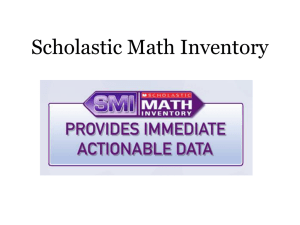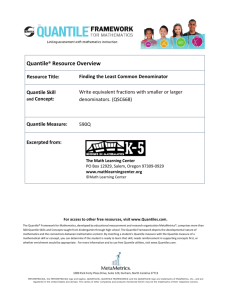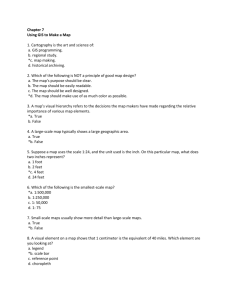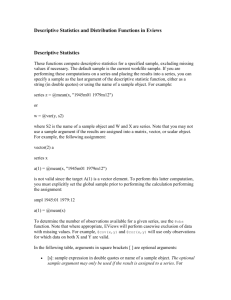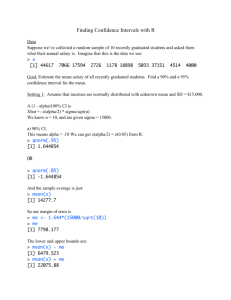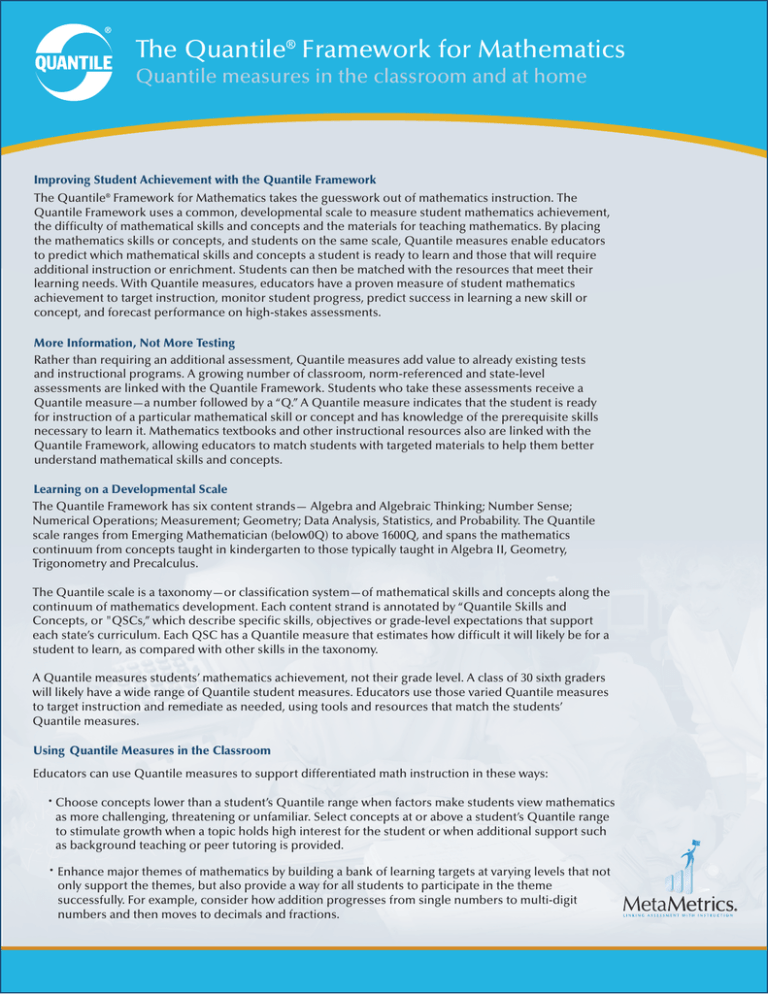
The Quantile® Framework for Mathematics
Quantile measures in the classroom and at home
Improving Student Achievement with the Quantile Framework
The Quantile® Framework for Mathematics takes the guesswork out of mathematics instruction. The
Quantile Framework uses a common, developmental scale to measure student mathematics achievement,
the difficulty of mathematical skills and concepts and the materials for teaching mathematics. By placing
the mathematics skills or concepts, and students on the same scale, Quantile measures enable educators
to predict which mathematical skills and concepts a student is ready to learn and those that will require
additional instruction or enrichment. Students can then be matched with the resources that meet their
learning needs. With Quantile measures, educators have a proven measure of student mathematics
achievement to target instruction, monitor student progress, predict success in learning a new skill or
concept, and forecast performance on high-stakes assessments.
More Information, Not More Testing
Rather than requiring an additional assessment, Quantile measures add value to already existing tests
and instructional programs. A growing number of classroom, norm-referenced and state-level
assessments are linked with the Quantile Framework. Students who take these assessments receive a
Quantile measure—a number followed by a “Q.” A Quantile measure indicates that the student is ready
for instruction of a particular mathematical skill or concept and has knowledge of the prerequisite skills
necessary to learn it. Mathematics textbooks and other instructional resources also are linked with the
Quantile Framework, allowing educators to match students with targeted materials to help them better
understand mathematical skills and concepts.
Learning on a Developmental Scale
The Quantile Framework has six content strands— Algebra and Algebraic Thinking; Number Sense;
Numerical Operations; Measurement; Geometry; Data Analysis, Statistics, and Probability. The Quantile
scale ranges from Emerging Mathematician (below0Q) to above 1600Q, and spans the mathematics
continuum from concepts taught in kindergarten to those typically taught in Algebra II, Geometry,
Trigonometry and Precalculus.
The Quantile scale is a taxonomy—or classification system—of mathematical skills and concepts along the
continuum of mathematics development. Each content strand is annotated by “Quantile Skills and
Concepts, or "QSCs,” which describe specific skills, objectives or grade-level expectations that support
each state’s curriculum. Each QSC has a Quantile measure that estimates how difficult it will likely be for a
student to learn, as compared with other skills in the taxonomy.
A Quantile measures students’ mathematics achievement, not their grade level. A class of 30 sixth graders
will likely have a wide range of Quantile student measures. Educators use those varied Quantile measures
to target instruction and remediate as needed, using tools and resources that match the students’
Quantile measures.
Using Quantile Measures in the Classroom
Educators can use Quantile measures to support differentiated math instruction in these ways:
· Choose concepts lower than a student’s Quantile range when factors make students view mathematics
as more challenging, threatening or unfamiliar. Select concepts at or above a student’s Quantile range
to stimulate growth when a topic holds high interest for the student or when additional support such
as background teaching or peer tutoring is provided.
· Enhance major themes of mathematics by building a bank of learning targets at varying levels that not
only support the themes, but also provide a way for all students to participate in the theme
successfully. For example, consider how addition progresses from single numbers to multi-digit
numbers and then moves to decimals and fractions.
The Quantile Framework for Mathematics
Quantile measures in the classroom and at home
Using Quantile Measuresin the Classroom (Continued)
· Sequence mathematical learning targets according to their difficulty as
much as possible.
· Develop a mathematics folder that goes home with students and returns weekly
for review. The folder can contain examples of learning targets within a student’s
Quantile range, applications of topics outside the classroom, reports of recent
assessments, and a parent form to record the amount of time spent on
mathematics investigations at home.
· Develop lists of learning targets that are tailored to provide appropriately
challenging and curriculum suitable for students.
Using Quantile Measures at Home
Parents can use Quantile measures to support their child’s progress in these ways:
· Ensure that a child gets plenty of mathematical experiences, concentrating
on concepts within his or her Quantile range. Parents can ask the child’s
teacher to print a list of appropriate learning targets or search the
Mathematical Skills Database at www.Quantiles.com.
· Communicate with the child’s teachers about his or her mathematical needs
and accomplishments. Teachers can use the Quantile scale to describe their
assessment of the child’s mathematical achievement.
· When a new topic proves too challenging for a child, use activities or other
materials from the Math Skills Database at www.Quantiles.com to help.
Review the prerequisite skills and concepts to ensure that gaps or
misconceptions are not interfering with the current topic.
· Celebrate a child’s mathematical accomplishments. The Quantile
Framework provides an easy way for students to track their own growth.
Parents and children can set goals for mathematics—spending so much time
daily working on math investigations; discussing situational topics, such as
statistics from a newspaper or discounts at the store; reading a trade book
about a mathematical topic; or trying new kinds of websites and games.
When children reach a goal, make it an occasion!
The Science Behind the Quantile Framework
Launched in 2004, the Quantile Framework was created by the psychometric
team at MetaMetrics®, an educational measurement and research
organization. Based in part on the organization’s more than 20 years of
psychometric research, the release of Quantile measures came after four
years of development, including an extensive national field study during the
2003–2004 school year.
METAMETRICS®, the METAMETRICS® logo and tagline, LEXILE, LEXILE® FRAMEWORK LEXILE® ANALYZER, the LEXILE® logo,
QUANTILE®, QUANTILE® FRAMEWORK and the QUANTILE® logo are trademarks of MetaMetrics, Inc., and are registered
in the United States and abroad. The trademarks and names of other companies and products mentioned herein are the
property of their respective owners. Copyright © MetaMetrics, Inc. All rights reserved.
MetaMetrics, an educational measurement
and research organization, develops
that link assessment with targeted
instruction to improve learning. The
organization’s psychometric team
developed the widely used Lexile
Framework for Reading; El Sistema Lexile
para Leer, the Spanish-language version of
the reading framework; The Quantile
Framework for Mathematics; and The Lexile
Framework for Writing. In addition to
licensing Lexile and Quantile measures to
state departments of education, testing and
instructional companies, and publishers,
MetaMetrics offers professional
development, resource measurement and
customized consulting services.
For more information on
using Quantile measures in
the classroom and at home,
call 1–888–539–4537 or
visit www.Quantiles.com.
1000 Park Forty Plaza Drive, Suite 120
Durham, North Carolina 27713
919–547–3400/1–888–539–4537
www.Quantiles.com



